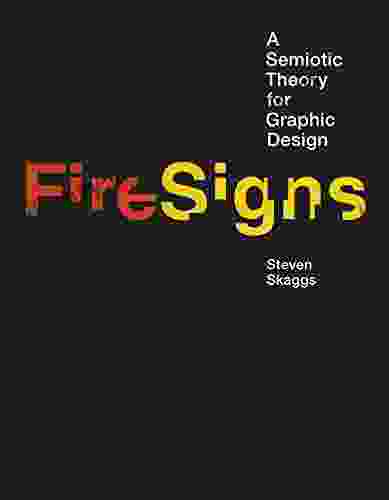Semiotic Theory for Graphic Design: Unveiling the Language of Visual Communication

Graphic design is a powerful form of communication that conveys messages through visual elements. To create effective and engaging designs, it is crucial to understand the underlying language of visual communication: semiotics.
4.4 out of 5
| Language | : | English |
| File size | : | 13912 KB |
| Text-to-Speech | : | Enabled |
| Screen Reader | : | Supported |
| Enhanced typesetting | : | Enabled |
| Print length | : | 383 pages |
Semiotics is the study of signs, symbols, and their meanings. It explores how we create and interpret meaning through visual, verbal, and other forms of communication. By understanding semiotic theory, graphic designers can harness the power of visual language to convey complex ideas, evoke emotions, and drive desired actions.
The Semiotic Triangle
A fundamental concept in semiotics is the semiotic triangle, proposed by Ferdinand de Saussure. It consists of three elements:
- Signifier: The physical or tangible representation of a sign, such as an image, a word, or a gesture.
- Signified: The concept or idea that the sign represents.
- Referent: The real-world object or event that the sign refers to.
For example, the image of a red rose (signifier) represents the concept of love or romance (signified),which refers to the emotion experienced in a relationship (referent).
Types of Signs
Semiotics classifies signs into different types based on their relationship between the signifier and the signified:
- Iconic signs: Resemble or mimic their referent, such as a photograph or a painting.
- Indexical signs: Indicate or point to their referent, such as smoke indicating fire or a fingerprint identifying a person.
- Symbolic signs: Have an arbitrary or conventional relationship with their referent, such as the word "tree" or the national flag of a country.
Denotation and Connotation
Semiotic theory also distinguishes between denotation and connotation in the meaning of signs:
- Denotation: The literal or primary meaning of a sign, which is fixed and universally understood.
- Connotation: The secondary or inferred meanings that are associated with a sign, which vary depending on cultural, social, or personal context.
For instance, the image of a heart (denotation: organ) might also connote love, romance, or passion (connotation).
Applications in Graphic Design
Semiotic theory provides valuable insights for graphic designers by:
- Enhancing Visual Communication: Helping designers use visual elements effectively to convey specific messages and evoke desired responses.
- Creating Brand Identity: Enabling designers to develop unique and recognizable brand identities that resonate with target audiences.
- Designing User Interfaces: Guiding designers in creating user-friendly and intuitive interfaces that communicate information clearly and facilitate interaction.
- Evaluating Design Effectiveness: Providing a framework for evaluating the effectiveness of graphic designs by analyzing their semiotic qualities.
Semiotic theory is an essential tool for graphic designers who seek to create visually compelling and meaningful designs. By understanding the principles, concepts, and methods of semiotics, designers can harness the power of visual language to communicate effectively, evoke emotions, and drive desired actions.
The exploration of semiotic theory for graphic design is a journey that continues to inspire and empower designers. By embracing this knowledge, designers can unlock new possibilities for visual communication and create designs that resonate with audiences and leave a lasting impact.
4.4 out of 5
| Language | : | English |
| File size | : | 13912 KB |
| Text-to-Speech | : | Enabled |
| Screen Reader | : | Supported |
| Enhanced typesetting | : | Enabled |
| Print length | : | 383 pages |
Do you want to contribute by writing guest posts on this blog?
Please contact us and send us a resume of previous articles that you have written.
 Book
Book Novel
Novel Page
Page Chapter
Chapter Text
Text Story
Story Genre
Genre Reader
Reader Library
Library Paperback
Paperback E-book
E-book Magazine
Magazine Newspaper
Newspaper Paragraph
Paragraph Sentence
Sentence Bookmark
Bookmark Shelf
Shelf Glossary
Glossary Bibliography
Bibliography Foreword
Foreword Preface
Preface Synopsis
Synopsis Annotation
Annotation Footnote
Footnote Manuscript
Manuscript Scroll
Scroll Codex
Codex Tome
Tome Bestseller
Bestseller Classics
Classics Library card
Library card Narrative
Narrative Biography
Biography Autobiography
Autobiography Memoir
Memoir Reference
Reference Encyclopedia
Encyclopedia Ram Dass
Ram Dass Vowron Prime
Vowron Prime Leonardo Trasande
Leonardo Trasande Mark Blyth
Mark Blyth Mark R Anderson
Mark R Anderson Mike Smith
Mike Smith Tuttle Publishing
Tuttle Publishing Steve Roper
Steve Roper William Goldman
William Goldman Robert B Cialdini
Robert B Cialdini Suzy Favor Hamilton
Suzy Favor Hamilton Suze Guillaume
Suze Guillaume Philip Pullman
Philip Pullman Sabri Suby
Sabri Suby Patrick Lange
Patrick Lange Timothy Mclean
Timothy Mclean Michael Banton
Michael Banton Ray D Waddell
Ray D Waddell Roderic Ai Camp
Roderic Ai Camp Warren W Wiersbe
Warren W Wiersbe
Light bulbAdvertise smarter! Our strategic ad space ensures maximum exposure. Reserve your spot today!
 Vic ParkerFollow ·12.9k
Vic ParkerFollow ·12.9k Israel BellFollow ·10.7k
Israel BellFollow ·10.7k John Dos PassosFollow ·13k
John Dos PassosFollow ·13k Clay PowellFollow ·18.4k
Clay PowellFollow ·18.4k Stan WardFollow ·15.5k
Stan WardFollow ·15.5k Arthur MasonFollow ·14.8k
Arthur MasonFollow ·14.8k Dale MitchellFollow ·2k
Dale MitchellFollow ·2k David PetersonFollow ·16.4k
David PetersonFollow ·16.4k

 Brian Bell
Brian BellExploring The Natural World Through Mindful Expressive...
Unleash the...

 David Baldacci
David BaldacciJourney into the Enigmatic World of "Grass" by Sheri S....
Prepare to be captivated by "Grass," a...

 Dashawn Hayes
Dashawn HayesBusting Myths About Human Nature: Unraveling the Complex...
Challenging the...

 Ernest Hemingway
Ernest HemingwayNotes on Suicide: A Profound Exploration of the...
Suicide, a taboo subject shrouded in...
4.4 out of 5
| Language | : | English |
| File size | : | 13912 KB |
| Text-to-Speech | : | Enabled |
| Screen Reader | : | Supported |
| Enhanced typesetting | : | Enabled |
| Print length | : | 383 pages |
















